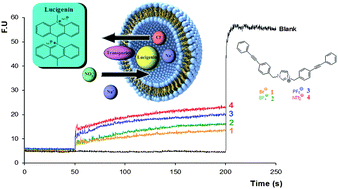
In a previous Communication Andreea R. Schmitzer and colleagues at University of Montréal demonstrated that imidazolium salts with low molecular weights have anionophoric properties, and that it was also possible to modulate the Cl– transport across a bilayer by complexing the imidazolium salt with cyclodextrins and cucurbituril, i.e. the anionic diffusion through the membrane could be activated or inhibited.
In this MedChemComm article Schmitzer et al. report the factors intrinsic to the imidazolium salts that are responsible for the salts’ ionophoric activity by:
1) Using the lucigenin method to demonstrate the influence of the nature of the imidazolium counter-anion on its anionophoric activity across the membrane of egg yolk phosphatidylcholine (EYPC) liposomes.
2) Describing the efflux of different anions using the pH-sensitive HPTS (8-hydroxypyrene-1,3,6-trisulfonic acid trisodium salt) method.
3) Presenting the kinetic parameters of the most active imidazolium salt, the EC50 and the rate constant characterising the efflux of the Cl–
Read the complete study by following the link below….
An anion structure–activity relationship of imidazolium-based synthetic transporters
Claude-Rosny Elie, Mathieu Charbonneau and Andreea R. Schmitzer
DOI: 10.1039/C2MD20107K










